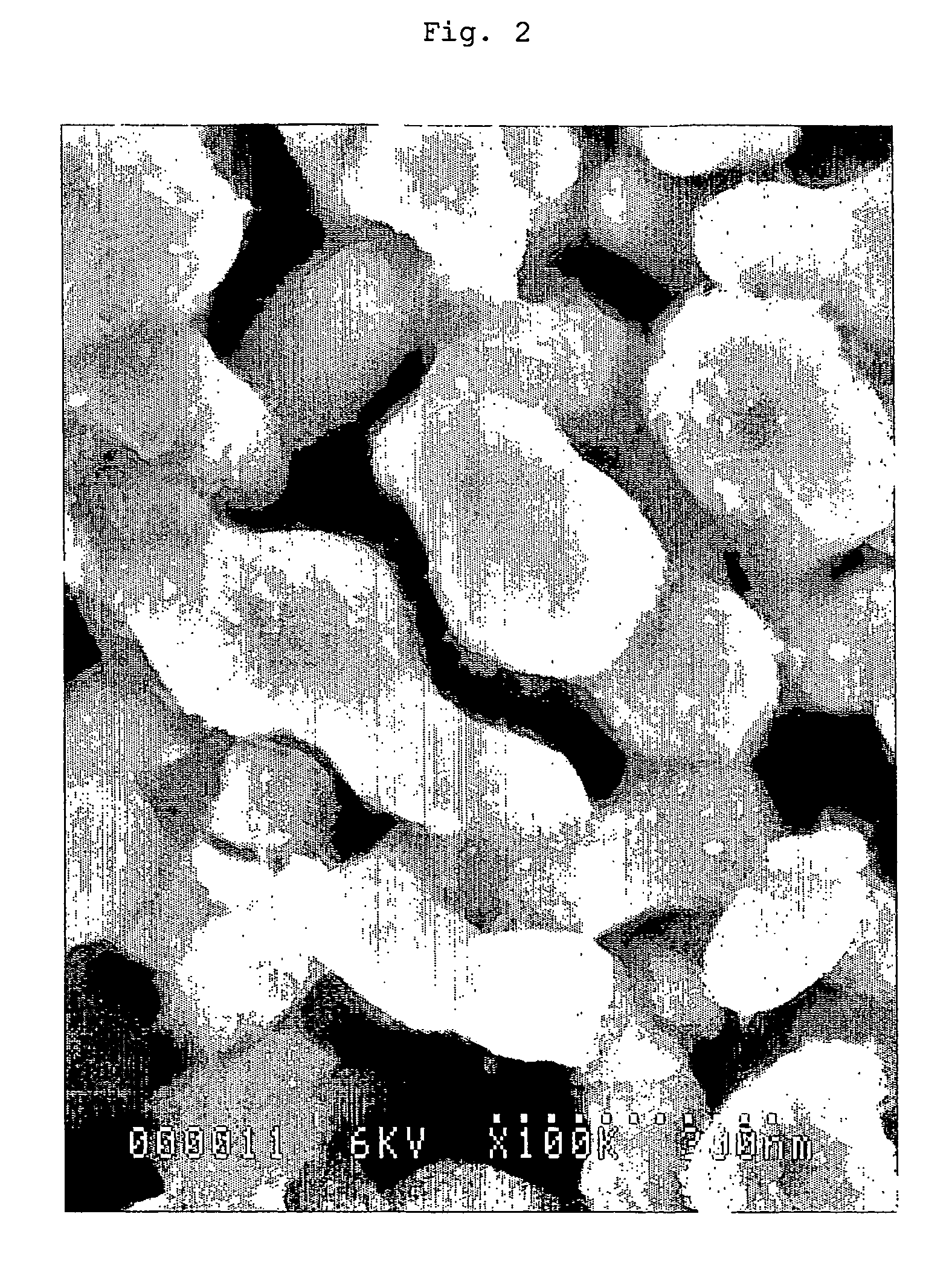Production method of a capacitor
a production method and capacitor technology, applied in the field of capacitors, can solve the problems of inability to achieve good esr value, inability to successfully form semiconductor layers, and inability to increase the impergnation ratio within a normal time, and achieve good esr performance, good performance, and high capacitance
- Summary
- Abstract
- Description
- Claims
- Application Information
AI Technical Summary
Benefits of technology
Problems solved by technology
Method used
Image
Examples
example 1
[0081] By using and shaping a tantalum powder having CV (product of capacitance and electrochemical voltage) of 150,000 μF·V / g together with a Ta lead wire of 0.24 mmφ, a sintered bodies in a size of 4.5×1.0×1.5 mm were produced (sintering temperature: 1,300° C., sintering time: 20 minutes, density of sintered body: 6.2 g / cm3; the Ta lead wire was vertically embedded in the center part of the 1.0×1.5 mm face of the sintered body while being buried 4 mm inside the sintered body and protruding 10 mm outside). On a separately prepared polyimide-made resin plate having a length of 250 mm, a width of 30 mm and a thickness of 2 mm (There are provided by printed wiring, on the front surface of the plate, a circuit connecting connection terminals for 32 electric conductors and respective anodes of current regulated diodes and reaching the power supply terminal in the left side of plate, and on the back surface, a circuit electrically connected only to the connection terminals for electric c...
example 2
[0086] An oxide dielectric film layer comprising Nb2O5 was formed through electrochemical formation at 23 V by using a niobium sintered body (made of powder having CV of 270,000 μF·V / g, nitrided amount: 10,000 ppm, amount of oxygen due to natural oxidation on the surface: 84,000 ppm, sintering temperature: 1,280° C., sintering time: 30 minutes, density of the sintered body: 3.4 g / cm3) and a niobium lead wire in place of the tantalum sintered body and the tantalum lead wire in Example 1. Then, a series of operations, that is, the sintered bodies were dipped in an alcohol solution of 2% ethylenedioxythiophene, pulled up, left standing, dipped in an alcohol solution of 18% iron naphthalenesulfonate, pulled up, left standing at 40° C. for 30 minutes and dipped in alcohol, were repeated seven times, whereby fine protrusions mainly comprising ethylenedioxy polymer were produced on the dielectric layer. When observed through SEM, the fine protrusions had an island- or string-like shape wit...
example 3
[0088] Capacitors were produced in the same manner as in Example 1 except for producing the sintered body (sintering temperature: 1,360° C., sintering time: 20 minutes, density of the sintered body: 6.0 g / cm3) by using tantalum powder having a CV value of 70,000 μF·V / g in place of the tantalum powder used in Example 1.
[0089] The capacitance, impregnation ratio, ESR value and LC value of each of the capacitors produced above were measured by the following methods. The measurement results (average values) are shown in Table 1.
Capacitance of the Capacitor:
[0090] The capacitance was measured at room temperature and 120 Hz by using an LCR measuring meter manufactured by Hewlett Packard, Ltd.
Impregnation Ratio:
[0091] This is a percentage of a numerical value obtained by dividing the capacitance of the capacitor by the capacitance of each electric conductor having formed thereon a dielectric layer as measured in 30% sulfuric acid. ESR value:
[0092] The equivalent series resistance o...
PUM
| Property | Measurement | Unit |
|---|---|---|
| Fraction | aaaaa | aaaaa |
| Electrical conductivity | aaaaa | aaaaa |
| Length | aaaaa | aaaaa |
Abstract
Description
Claims
Application Information
 Login to View More
Login to View More - R&D
- Intellectual Property
- Life Sciences
- Materials
- Tech Scout
- Unparalleled Data Quality
- Higher Quality Content
- 60% Fewer Hallucinations
Browse by: Latest US Patents, China's latest patents, Technical Efficacy Thesaurus, Application Domain, Technology Topic, Popular Technical Reports.
© 2025 PatSnap. All rights reserved.Legal|Privacy policy|Modern Slavery Act Transparency Statement|Sitemap|About US| Contact US: help@patsnap.com



